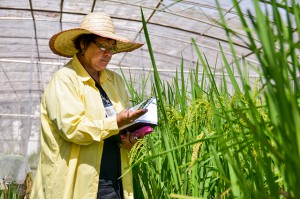A recent study identified promising breeding lines that are heat-tolerant and high-yielding after a series of field and laboratory heat stress screening. 
Titled “Screening of rice-induced mutants for heat and drought tolerance,” the study was among the posters presented under the Plant Breeding and Genetics category during the 23rd Federation of Crop Science Societies of the Philippines, Inc. Scientific Conference in Clark Zone, Pampanga, 11-16 May.
Thelma Padolina, lead researcher, said that screening promising lines that exhibit tolerance to drought and heat stress will pave way to the development of new varieties that addresses climate change in the country’s major rice-growing areas.
According to Padolina, although rice normally grows at temperatures between 20 and 35°C, it is at its most sensitive during the booting and flowering stages. Hence, even short-duration chronic dry spells occurring during these stages will result in substantial yield loss.
Padolina and her team started the series of screening in 2012 where 817 mutant lines were initially screened for drought stress and leaf blast, and later with emphasis to heat stress.
Mutant lines are valuable genetic variations for crop improvement. They are the results of induced mutation where one or two of their major traits, for instance plant height and resistance to biotic and abiotic stresses, were altered.
“In this study, we identified promising lines from five backgrounds: 2 from traditional rice varieties Ballatinaw and Azucena; 3 from modern varieties PSB Rc72H, PSB Rc4, and IR58; and 1 from Nipponbare,” said Padolina.
She added that promising lines were exposed to temperatures ranging from 21.1°C to 34.4°C at field trials, and 34°C to 38°C at screenhouse trials for 3 consecutive seasons to test and validate their grain fertility and pollen viability.
As of this writing, 9 mutant lines that exhibited more than 40% grain fertility under high temperature conditions have been identified.
The best lines among the mutant groups exhibited a yield of at least 6 t/ha. The Ballatinaw lines yielded 6 to 6.7 t/ha during the 2014 DS, followed by PSB Rc72H with 6-6.2 t/ha, and the Azucena lines with 2.7 to 4.3 t/ha, all better than their original parent stock. The Ballatinaw lines also exhibited good milling potential with 66.8-70% recovery in contrast with PSB Rc72H with only 59.3-63.7%.
Lenie Pautin, Rustom Braceros, Dindo Tabanao, and Arnel Pocsedio were the co-authors.




